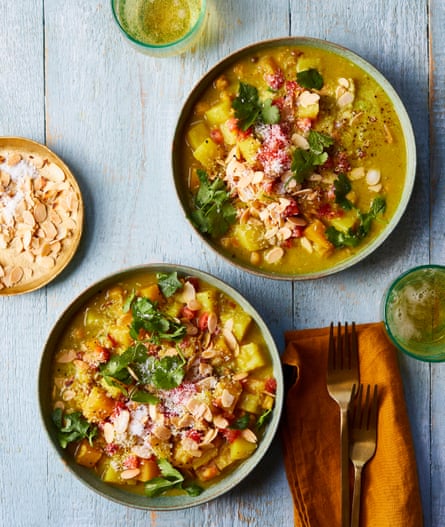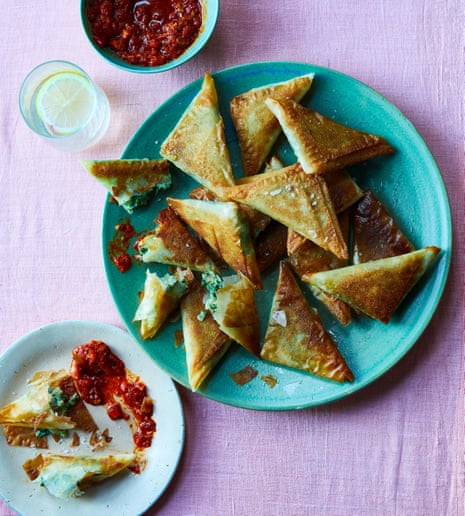Whenever I’m researching a new dish, whether it’s for the restaurants or for our Gauthier at Home boxes, I always look to come up with something that’s as familiar as possible, but with the animal produce removed. The trick, I find, is to replace it with an element that gives the same protein and umami satisfaction you get from meat. These two dishes are cases in point. Neither is intended to be super-authentic, but rather a lighthearted interpretation of the original with a soupçon of added Frenchness, because, well, I’m French.
Briouats (pictured above)
These little, crisp, north African parcels are a bit like samosas, and make the perfect starter or side dish; they bring an especially nice crunch when served alongside the likes of a stew.
Prep 15 min
Cook 35 min
Serves 4 (ie 2 per person)
4 tbsp olive oil
200g spinach
1 large potato (300g), peeled and roughly chopped
2 medium ripe tomatoes, chopped as finely as possible
1 tbsp roasted harissa paste – Le Phare du Cap Bon from Tunisia is my favourite
30g vegan cream cheese – I like Bute Island Sheese
30g vegan parmesan – I use Green Vie Parveggio
2 spring onions, trimmed and finely chopped
1 handful chives, finely chopped
1 handful parsley, finely chopped
Sea salt and black pepper
1 x 250g pack feuilles de brick, from Middle Eastern food stores and some supermarkets, or filo pastry
Heat a tablespoon of oil in a saute pan, add the spinach, and sweat, stirring, until it’s wilted. Take off the heat, leave to cool, then finely chop and put in a medium bowl.
Bring a medium saucepan of water to a boil, add the potato, boil for about 10 minutes, until cooked through, then drain.
While the potato is cooking, put the tomatoes in a medium bowl with the harissa, and stir with a fork until well combined.
Put the drained potato in the bowl with the chopped spinach, add the cream cheese, parmesan and finely chopped spring onion, and mash to combine. Stir in the chives and parsley, and season to taste.
Take one sheet of pastry (cover the rest, so it doesn’t dry out) and cut it lengthways into four strips about 7½cm wide x 20cm long. Put a dessert spoonful of the filling mixture at one end of one strip (be careful not to use too much and overfill the pastry, or it’ll burst), then fold the bottom corner up and over the filling, to make a triangle. Repeat from the other side, then continue zigzagging all the way along the length of the pastry, to cover and seal completely in a neat triangular package. Repeat with the remaining pastry and filling, to make eight triangular parcels in total.
Heat the three remaining tablespoons of oil in a frying pan, then shallow fry the parcels, in batches if need be, for about three minutes on each side, until golden and crisp all over. Drain on kitchen towel and serve hot with the tomato and harissa mix for dipping.
Persian-style chickpea stew

I’ve recently been struck by the simplicity and intense freshness of flavour found in Persian food. This is my take on khoresh gheymeh, a chickpea stew that’s very popular in Iran. It’s a bit 1970s and retro, but I don’t care: the way the coconut milk offsets the spices and delivers the chickpeas is sensational, while the freshness of the chopped tomato at the end, combined with the nuts, coconut and coriander, is a real crowdpleaser.
Prep 15 min
Cook 1 hr
Serves 4
100ml olive oil
2 large onions, peeled and very finely chopped
½ tsp turmeric
½ tsp ground cumin
½ tsp ground coriander
¼ tsp cinnamon
½ tsp ground ginger
½ tsp garlic powder
2 x 400ml tins coconut milk
200ml vegetable stock
1 large potato (300g), peeled and diced
175g swede, peeled and diced
1 x 400g tin cooked chickpeas in water
50g sultanas
1 big pinch saffron threads
Salt and black pepper
1 good beef tomato (400g)
50g toasted almond flakes
100g desiccated coconut
1 big handful fresh coriander, roughly chopped
Heat the oil in a heavy-based frying pan, then add the onions, and sweat very slowly, stirring regularly, for about 25 minutes, until translucent and caramelised, like hotdog onions; be careful not to take them too far and burn them, though. Stir in all the spices except the saffron, and cook on a very low heat for another 10 minutes. Add the coconut milk and vegetable stock, bring up to a simmer, then add the potato, swede, chickpeas and their water (the starchy aquafaba will help give the stew a welcome silkiness), sultanas and saffron, season to taste and leave to simmer for about 20 minutes, until the potatoes are tender.
Skin and deseed the tomato (cut a little cross into the base, then blanch in boiling water for five or so seconds, and the skin should come off easily), then finely dice the flesh. Taste the stew, adjust the seasoning to taste, then ladle into a serving bowl and spoon the diced fresh tomato on top. Scatter over the almonds, desiccated coconut and fresh coriander, and eat just as it is, or with plain rice or couscous.

Comments (…)
Sign in or create your Guardian account to join the discussion